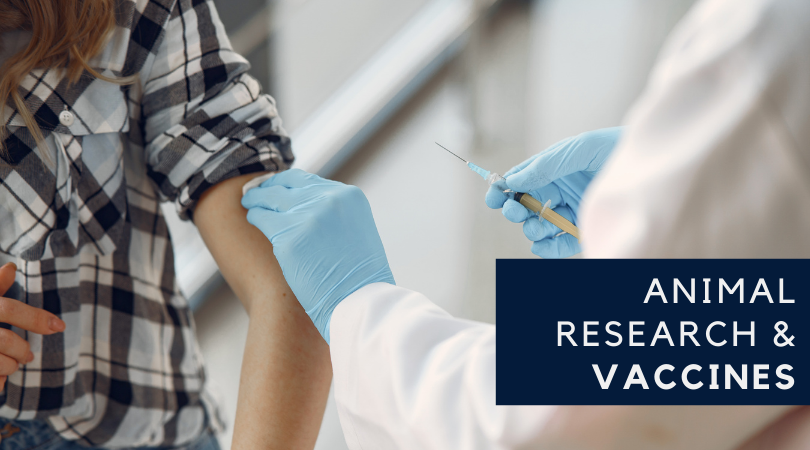How is a Vaccine Created? Animal Research Plays a Key Role
Posted on
Before a vaccine can be used to protect humans from a specific disease, there is a long, careful process involving extensive research and testing to determine two main things: whether the vaccine works, and whether it is safe to use in people.
 There are three primary stages of vaccine research and testing before a vaccine is made available to the public:
There are three primary stages of vaccine research and testing before a vaccine is made available to the public:
- Exploratory research
- Pre-clinical research
- Clinical development
While clinical research and trials are conducted in humans, the first two stages of vaccine development—exploratory research and especially pre-clinical research—depend on animal studies.
The Exploratory Stage of Vaccine Development
The exploratory phase of vaccine research involves laboratory research and can last several years. Once scientists have identified a target disease and obtained the necessary funding, they attempt to identify natural or synthetic antigens that could prevent or treat that disease.
One of the most important steps in exploratory vaccine research is identifying the type of antigen on which to build the vaccine.
There are several different vaccines types, including:
- Whole pathogen vaccines, which use a whole virus that has been weakened (live-attenuated) or inactivated
- Subunit vaccines, which contain only a portion of a virus or bacteria
- Toxoid vaccines, which use weakened or inactive toxins
- Virus-like particle (VLP) vaccines, which mimic the virus to prompt an immune response
- Nucleic acid vaccines, including mRNA, DNA plasmid, and recombinant vector vaccines, which use genetic material to incite the body to produce its own antigens
Many different antigens may be identified and tested in the exploratory phase, and many of those will be rejected for a wide variety of reasons. If a vaccine candidate shows promise in the exploratory phase, it moves on to the pre-clinical stage.
The Pre-Clinical Stage of Vaccine Development
The pre-clinical stage of vaccine development uses cell culture, tissue culture, and in vivo testing in animals to assess both the safety of the vaccine candidate and its ability to provoke an immune response. Usually, mice and rats are used in pre-clinical vaccine research, but studies may also be done with other animals, including guinea pigs, ferrets, pigs, sheep, turkeys, and monkeys.
In recent years, scientists have been using transgenic, or “humanized” mice—mice that have been genetically modified to carry functioning human material, including genes, cells, tissues, or organs—in vaccine research and other pre-clinical research. Using humanized rather than traditional lab mice makes for an animal model that is closer to a human, which enables researchers to more accurately determine how the human body will react to the vaccine candidate.
While an immune response is the desired reaction, there may be others that bear study during this stage, including toxicity and interactions with other elements of the immune system.
Working with animal models enables researchers to test different dosages and methods of administration and monitor the animals for both positive and negative reactions on the cellular level.
In addition, researchers can readily test the efficacy of the vaccine candidate by trying to infect animal models with the target disease after they have been vaccinated, to see if the vaccine does indeed prevent them from getting sick—a process that is too dangerous to be done with humans.
The pre-clinical stage is also the period during which researchers determine the appropriate dosages of the vaccine, and the form in which it should be administered (pill, injection, aerosol, etc.)
Once the pre-clinical stage of vaccine development has been completed, the process moves to the clinical stage, which involves three stages of testing on humans.
The Clinical Stage of Vaccine Development
Phase I Vaccine Trials: Conducted with a small group of adult volunteers (usually less than 100) who are at low risk of contracting the disease targeted by the vaccine candidate, to assess the safety of the vaccine candidate and determine whether it provokes the intended immune response.
Phase II Vaccine Trials: Conducted with a larger group of human volunteers, some of which may be in the target group that is most susceptible to the disease (based on age, physical health, risk factors, etc.) to test the vaccine candidate’s efficacy, safety, dosage, immunization schedule, and method of delivery.
Phase III Vaccine Trials: This last stage of human trials involves testing the vaccine candidate with a much larger group, up to tens of thousands of people. The goal of phase III vaccine trials is to assess the effectiveness and safety of the vaccine in a large group of people and to monitor any side effects that may occur.
If all three clinical trial phases are successful, the vaccine maker will apply to the FDA for approval, and if it is granted the vaccine will move into large-scale manufacturing and distribution. At this point, many vaccines enter phase IV, when the vaccine is subjected to ongoing study and monitoring after it is approved for use.
The development of a vaccine is a process that usually takes many years, and while scientific study and human volunteers play a large role in vaccine development, the foundation of most vaccines is built on the indispensably valuable animal model.